Oldstead Grange was founded by the
monks from nearby Byland Abbey who gave the name
"Grange" to indicate a farm they owned and
worked. "Oldstead" indicates the original
site occupied while the Abbey was being built.
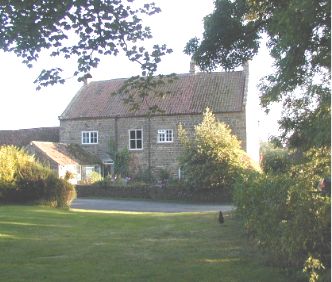
The farmhouse at
Oldstead Grange was built in the 17th century from
the local soft red sandstone and has walls almost 2
feet thick. The plaster has recently been removed
from the walls around the staircase to create a rich
feature of the stone.

Amongst the depth of the
chimney breasts as they lead up from the inglenooks
towards the attic is a chamber believed to have been
a priest hole. The fireplace in the guest sitting
room was constructed more recently from cobbles which
were gathered from our arable fields above the house.
This room also features oak furniture made in the
medieval style by the Robert Thompson Craftsmen of
Kilburn.
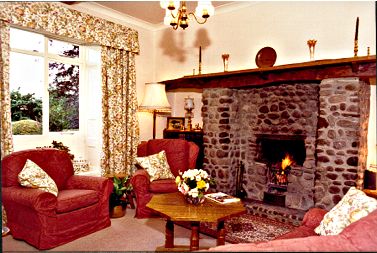
We serve a breakfast of your
choice, including a range of teas and coffees, fresh
fruit salad and juices, yoghurts, breads and croissants. Speciality Oldstead Grange dishes
include a traditional grill with free range eggs from our own hens and dry
cured Yorkshire bacon, scrambled eggs with smoked salmon, omelette,
creamed mushrooms, kedgeree and selection of cold meat and cheeses.
Click
for a Sample Menu
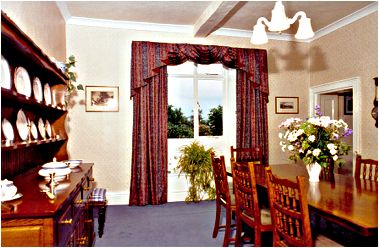
Stone
millstones which
were once used to grind feed for the farm animals are
built into the cobbled garden wall. On display in the
garden is a collection of stone querns (examples of
much more ancient hand grinding devices) which were
unearthed by several generations of our family whilst
ploughing the land.
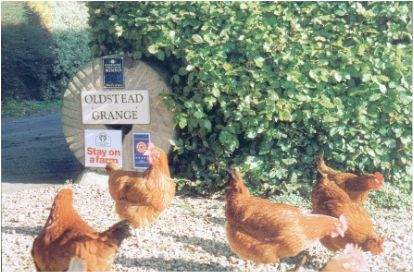
Eggs for breakfast are guaranteed fresh!
Walk
in our fields to discover history and wildlife
(perhaps join one of the public footpaths) and return
to relax in the garden.
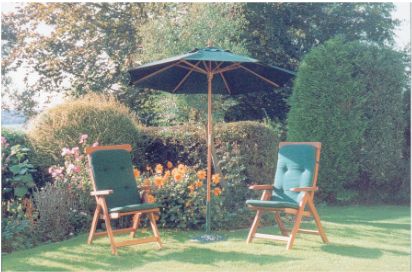
We have produced our
own guide for walks round the farm and have maps and
books available for visitors to use.
In medieval times, the valley
below was a fishing lake with
the largest earth dam in England creating a 30 acre
lake across the bottom of our land. Though the lake
has long since been drained visitors are able to
discover the dam, which, being lined with trees, is
not readily obvious in the landscape. The farm
spreads over several small hills and valleys beneath
the steep forested edge of the Hambleton Hills. The
higher points are about 400 feet above sea level and
provide spectacular views across a broader (2 mile
wide) valley to the Howardian Hills and out across
the Vale of York to the Pennines, 30 miles in the
distance.

Across the valley towards Coxwold (right) and Newburgh Priory (left) and the
Howardian Hills
There are several officially marked
footpaths crossing the farm which lead over the
fields to Byland Abbey, Coxwold and Kilburn. Our
visitors are welcome to explore the farm to discover
the history, nature and wildlife. Springtime reveals
several acres of bluebell woods and clearings amongst
the bushes covered in primroses and violets.
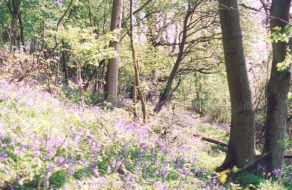
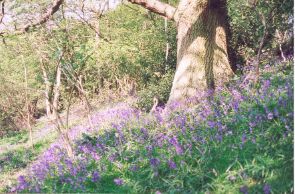
Peat
lies under the boggy areas encouraging the growth of
irises, marigolds, milkmaids and even orchids. The
beck is fed by numerous springs which, with hard
water and high levels of dissolved minerals, are
surrounded by mounds of a stony deposit called tufa.
Alongside the beck there are some rather unique bay
willows which on warm summer evenings fill the air
with a sweet scent. Wild duck and heron can be seen
flying off the water along with an occasional glimpse
of the family of deer which moves between the woods.
When we are ploughing, a kestrel hawk often hovers
and even follows between fields hoping for its prey
to be disturbed.
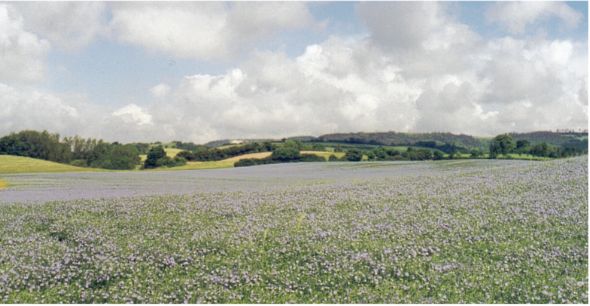
The view looking north west from Oldstead Grange across our fields towards
the Kilburn White Horse in the distance. This is a crop of linseed in full
flower in May.
